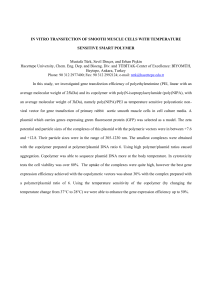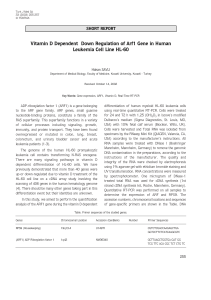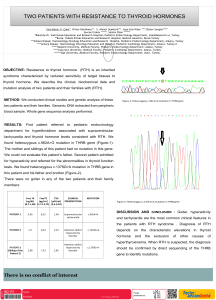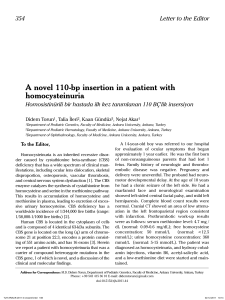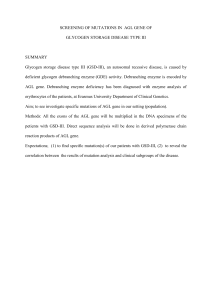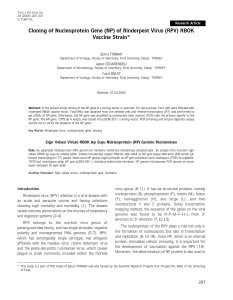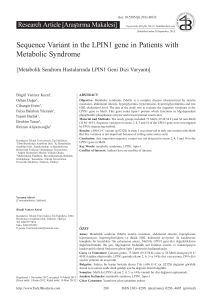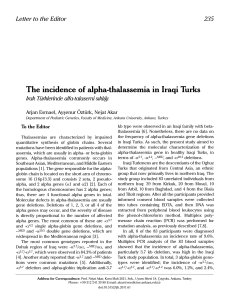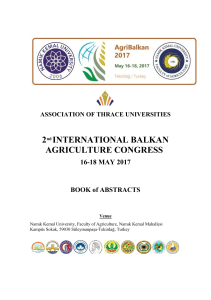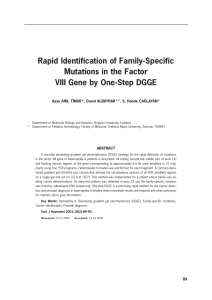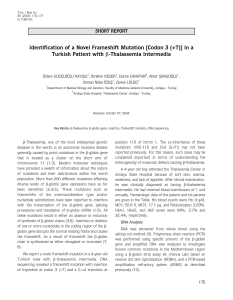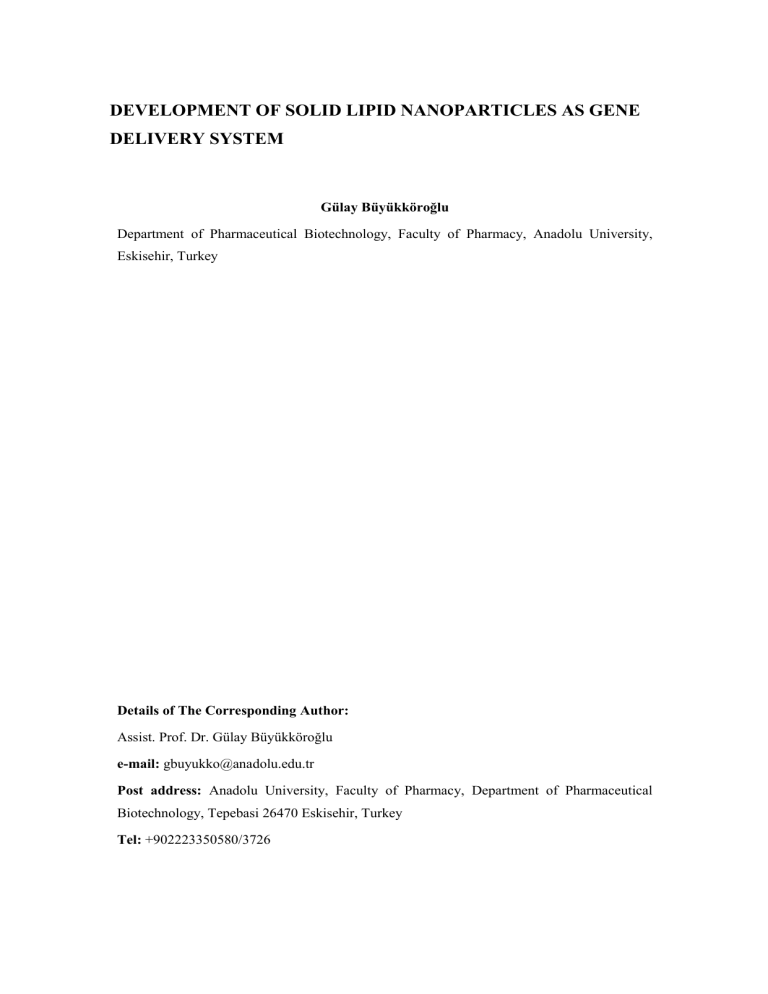
DEVELOPMENT OF SOLID LIPID NANOPARTICLES AS GENE
DELIVERY SYSTEM
Gülay Büyükköroğlu
Department of Pharmaceutical Biotechnology, Faculty of Pharmacy, Anadolu University,
Eskisehir, Turkey
Details of The Corresponding Author:
Assist. Prof. Dr. Gülay Büyükköroğlu
e-mail: gbuyukko@anadolu.edu.tr
Post address: Anadolu University, Faculty of Pharmacy, Department of Pharmaceutical
Biotechnology, Tepebasi 26470 Eskisehir, Turkey
Tel: +902223350580/3726
ABSTRACT
As a natural result of the progresses made in the recombinant DNA technology, the gene treatment
has been brought forward for the improvement of genetic disorders. The purpose of the gene therapy
is the treatment of the infection and genetic disorders with the introduction of new genetic materials
among cells taken from the body. The objective of our study is to develop a new gene carrier system
that can bind the DNA through electrostatic interaction by cationic solid lipid nanoparticulate
(SLN) system with the help of a cationic lipid. In preparation of the SLNs, two different lipids
including mono-, di- and triglyceride mixtures (Gelucire 50/13 Pastilles) and glycerol distearate
(Precirol ATO 5) were selected as lipid matrixes. The particle sizes of the prepared cationic solid
lipid particles were found to be between 50.55 ± 0.12 and 168.2 ± 0.35 nm. Their zeta potentials
which constitute of an important characteristic for the stability were determined to be between -50.2
± 0.16 and +37.1 ± 0.63 mV. Increasing the ratio of cationic lipids in SLN have been observed to
increase the zeta potentials and the toxic properties on HEK 293 cells of SLNs. The DNA binding
abilities of SLNs were found to be varied.
Key words: Solid lipid nanoparticle (SLN), gene delivery system, cationic carrier system.
Kati Lipit Nanopartiküllerin Gen Taşıyıcı Sistem Olarak Geliştirilmesi
Rekombinant DNA teknolojisindeki ilerlemelerin doğal sonucu olarak, kalıtsal hastalıkların
iyileştirilmesi için gen tedavisi gündeme gelmiştir. Gen tedavisinde amaç, vücuttan alınan hücreler
içinde yeni genetik materyalin tanıtılmasıyla, enfeksiyon ve genetik hastalıkların tedavisidir.
Çalışmamızın amacı, katı lipit nanopartiküler (KLN) sisteme, katyonik bir lipit yardımıyla katyonik
özellik kazandırılarak, DNA’ya elektrostatik etkileşme ile bağlanabilecek yeni bir gen taşıyıcı sistem
geliştirmektir. SLN’lerin hazırlanmasında lipit matris olarak mono-, di- ve trigliserid karışımı
(Gelucire 50/13 Pastilles) ve gliserol distearat (Precirol ATO 5) olmak üzere farklı iki lipit
seçilmiştir. Hazırlanan katyonik katı nanopartikülleri, partikül boyutu 50.55 nm ve 168.2 ± 0.35 nm
aralığında bulunmuştur. Kararlılıkları için önemli özellik olan zeta potansiyelleri ise -50.2 ± 0.1 ile
+37.1 ± 0.63 mV aralığında belirlenmiştir. Katyonik lipidin oranının arttırılması ile SLN’lerin zeta
potansiyelinde ve 293 HEK hücrelerinde toksik özelliğinin arttığı gözlenmiştir. SLN’lerin DNA
bağlama yetilerinin farklılık gösterdiği belirlenmiştir.
Anahtar Kelimeler: Katı lipit nanoparltikül (KLN), gen taşıyıcı sistem, katyonik taşıyıcı sistem
INTRODUCTION
The studies on gene treatment are promising in the treatment and prevention of the genetic
and infectious diseases as well as the cancer because of the recent developments in the field of
the molecular biology (1). In the process to date, the conventional use of drugs in the treatment
of cancer and viral diseases are now being replaced with the gene therapy. This type of
treatment aims to deliver the corrected genes to the patients or to correct the patient's genes. The
gene therapy is defined as transferring the genetic material to the specific cells to create a
therapeutic impact (2). The replacement of the damaged genes, putting back the lost genes or
the disease treatments by means of silencing the gene definitions have steered many studies in
recent years with the gene therapy that declared as the future revolution of the modern medicine
(3). The applications of gene therapy are either divided as somatic and germline gene therapy in
terms of the target issue, or as ex vivo and in vivo gene therapy in terms of its administration to
the patient (4).
For the ex vivo gene therapy, the cells are taken out from the affected tissue, and genetically
straight genes are transferred to these cells within a laboratory conditions. After the generation
of these cells, the treated cells are picked up from other cells, and applicated to the patient via
vaccination or transplantation methods. Using the patient's own cells, no immunological impacts
are seen following the vaccination or transplantation (4).
For the in vivo gene therapy, it is tried to be performed through the direct transfer of the healing
gene to the patient's cells in the body, without removing the sick cells, with the help of vectors
(delivery systems) (5).
There needs to be a suitable genetic carrier for the transfer of the gene. For this purpose, viral
and nonviral vectors were used for gene delivery (6).
It has been demonstrated that the viral
vectors have a much higher transfection impact in many cells compared to the non-viral vectors.
However, as the viral vectors have a mutation, a recombination or an oncogenic impact and high
costs, the studies on the non-viral vectors have been increased (7).
The non-viral vectors are such systems that can carry a gene material that has a low immune
response, ease of synthesis, and an unlimited size (8). The mostly studied non-viral vectors are
liposomes and nanoparticulate systems. These are polymeric, lipidic, and peptide-protein
structures allowing for simple packaging of genetic material, majority of which have cationic
characteristics, and enable the transfection of the genetic material into the cell (9).
In our study, the solid lipid nanoparticles (SLN) were selected as non-viral vectors. At the
preparation stages, the cationic lipid (octadecylamine) added into the matrix lipid brought a
positive characteristics to the negative charge SLNs (10, 11). It is known that the positive
charge SLNs and pDNA electrostatically interact with each other and create a complex (12).
The SLNs are offered as an alternative drug delivery systems to the liposomes, polymeric
nanoparticles, and emulsions (13). SLNs are similar to the emulsions and liposomes, and consist
of such materials that can be physiological well-tolerated (14).
The objective of this study is to prepare the nano-size DNA binding solid lipid
nanoparticulate systems so as to be used in gene treatment, and to determine their characteristics
and toxic effects.
METHODS
Materials
As solid lipids, three lipids with different melting points (50 °C and 56 °C) including mono-,
di- and triglyceride mixture (Gelucire 50/13 Pastilles) and glycerol distearate (Precirol ATO 5)
were supplied from Gattefosse. As the surfactants, polyoxyethylene-20-sorbitan monooleate
(Tween 80, Fluca) and Sorbitan Trioleate (Span 85, Sigma) were used. As cationic agent, the
stearylamine (octadecylamine, Fluka) was chosen. The Plasmid DNA (MB113, Pharm. Dev)
was supplied by Cambio Ltd. and the gWiz™ GFP plasmid used for transfection was obtained
from Aldevron. To determine the cytotoxicities and transfection activity of the formulations,
there was studied on Human Embryonic Kidney 293 (293 HEK) cells (ATCC).
Preparation of SLNs
In preparation of the cationic SLNs, the simple technique of generating oil-in-water emulsion
was used. The lipids used in the preparation of SLNs each containing cationic lipid, were melted
at about 10 °C above the melting point of each lipid and added to the hot aqueous surfactant
solutions that were heated to same degree as lipids. The molten lipids were added in the hot
surfactant solutions and the mixture was sonicated for 2 min at 20 % power using a sonicator
(Sonics, USA). The codes and contents of the formulations are provided in the Table 1.
Table1. The codes and contents of the SLNs
Codes
Solid Lipid
(% w/w)
Cationic Lipid
(% w/w)
®
Tween 80
(% w/w)
G
GI
GII GIII
Gelucire 50/13
GIV
P
PI
PII
PIII
Precirol ATO 5
PIV
4
4
4
4
4
4
4
4
4
4
-
0.25
0.30
0.35
0.50
-
0.25
0.30
0.35
0.50
2.8
2.8
2.8
2.8
2.8
2.8
2.8
2.8
2.8
2.8
®
Span 85
(% w/w)
Heating
Degrees
1.2
1.2
1.2
60 ± 1°C
1.2
1.2
1.2
1.2
1.2
1.2
1.2
66± 1°C
Characterization of SLNs
Particle size and zeta potential
Mean diameter of the bulk population and the particle distribution via the PI and zeta
potentials of SLNs analyzed by a Zetasizer NanoZS (Malvern Instruments, UK). Distilled water
with a conductivity value of 50 µS/cm was adjusted using sodium chloride (0.1 N) at pH 7.4 and
used in zeta potential analyses. Electrostatic mobility was converted to zeta potential using the
Helmholtz Smoluchowski equation. For this purpose, 50 µL of the SLNs were dispersed in 1
mL of this distilled water and particle size, PI, and zeta potentials were determinated.
Gel Retardation
Gel retardation studies were used to determine DNA binding ratio of SLNs. Different ratios
of pDNA/SLN (µg/µL) complexes were prepared and loaded on an agarose gel and visualized
by 1.5 % ethidium bromide staining for 2 h at 25 V. Images were obtained using Kodak Image
Station 440 CF (USA).
Cytotoxicity of SLNs
Colorimetric 3-(4,5-dimethylthiazol-2-yl)-2,5-diphenyltetrazolium bromide (MTT) method
was used for the quantitative determination of cell cytotoxicity. 293 HEK cell line was used in
the method. Briefly, 2×104 cells were seeded within a 96-well plate (Greiner, Sigma-Aldrich).
Cells were incubated at 37°C for 24 hours in a humidified atmosphere containing 5% CO 2.
After 24 hours of incubation, supernatant of each well was replaced with different
concentrations of formulations, and the plates were incubated at 37°C for another 4 hours. Then
the medium was withdrawn, fresh medium was added to cells, and the plates were re-incubated
for 48 hours. At the end of the incubation time, supernatant of each well was replaced with 20
µL MTT dye (Sigma-Aldrich) (diluted with PBS for 5 mg/mL concentration) solution and the
plates were incubated in the same previous conditions for 4 hours. 200 µL spectrophotometric
DMSO was then added to each well to dissolve formazan crystals. After 30 min of incubation,
absorbance of the plate was measured at 570 nm using a spectrometric microplate reader (Perkin
Elmer Victor X5, England).
Transfection of SLNs
To determine the transfection efficacy of lipidic particles, gWiz™ GFP plasmid
that
encodes the gene for the Green Fluorescent Protein (GFP) was used as pDNA. 293 HEK cell
lines were seeded with antibiotic-free medium in a 6-well plate and incubated at 37°C for 24 h
with 5 % CO2 until the cell intensity elevated to 60-70 %. gWiz™ GFP plasmid/PP (2 µg) 25
µL SLNs were incubated at room temperature for 30 min to maintain adsorption of negatively
charged pDNA on positively charged particles. Than these complexes were diluted with 1 mL
antibiotic/FBS-free medium and added drop-wise to the cells. After 48 h incubation, 20
different areas were selected among the all wells for counting both the transfected and nontransfected total cells (10). Transfection efficiency (TE) was calculated using following
Equation (1).
(Eq.1)
RESULTS
Particle size and zeta potential
Mean particle size, particle sizes distributions and zeta potentials of the SLNs are given in
Table 2.
Table 2. Mean particle sizes and particle size distributions of the SLNs.
G
GI
GII
GIII
GIV
PS (nm) ± SE
50.55 ± 0.12
87.11 ± 0.34
61.22 ± 0.19
52.56 ± 0.21
51.66 ± 0.34
PI ± SE
0.670 ± 0.134
0.585 ± 0.231
0.492 ± 0.213
0.476 ± 0.019
0.568 ± 0.126
-26.3 ± 0.12
15.9 ± 0.03
19.5 ± 0.10
20.2 ± 0.14
20.2 ± 0.27
P
PI
PII
PIII
PIV
PS (nm) ± SE
110.8 ± 0.11
149.5 ± 0.09
133.4 ± 0.32
153.4 ± 0.46
168.2 ± 0.35
PI ± SE
0.409 ± 0.263
0.250 ± 0.248
0.272 ± 0.546
0.297 ± 0.265
0.398 ± 0.154
-50.2 ± 0.16
10.4 ± 0.51
27.1 ± 0.27
30.5 ± 0.26
37.1 ± 0.63
ZP (mV) ± SE
ZP (mV) ± SE
Experiments were carried out in triplicates. PS; Particle size, PI; Polydispersity index, ZP; Zeta
potentials and SE; Standard error.
Gel Retardation
Codes of the SLNs and ratios of pDNA/SLN (µg/µL) complexes are given in Table 3-5.
Complete binding of pDNA with SLNs was determined by the absence of free DNA bonds on
the gel images in Figure 1-3.
Table 3. Ratios of SLN:pDNA (µL/µg) and application area of
GI and PI coded SLNs/pDNA complexes on the gel.
pDNA
GI
PI
-
I
II
III
IV
I
II
III
IV
2µg
1:1
1:2.5
1:4
1:5
1:1
1:2.5
1:4
1:5
Ratios of SLN:pDNA (µL/µg)
Figure 1. Gel image of GI and PI coded SLNs/pDNA complexes.
Table 4. Ratios of SLN:pDNA (µL/µg) and application area of GII,GIII and GIV coded
SLNs/pDNA complexes on the gel.
pDNA
GII
GIII
GIV
-
I
II
III
IV
I
II
III
IV
I
II
III
IV
2µg
1:1
1:2.5
1:4
1:5
1:1
1:2.5
1:4
1:5
1:1
1:2.5
1:4
1:5
Ratios of SLN:pDNA (µL/µg)
Figure 2. Gel image of GII,GIII and GIV coded SLNs/pDNA complexes.
Table 5. Ratios of SLN:pDNA (µL/µg) and application area of PII, PIII and PIV coded
SLNs/pDNA complexes on the gel.
pDNA
PII
PIII
PIV
-
I
II
III
IV
I
II
III
IV
I
II
III
IV
2µg
1:1
1:2.5
1:4
1:5
1:1
1:2.5
1:4
1:5
1:1
1:2.5
1:4
1:5
Ratios of SLN:pDNA (µL/µg)
Figure 3. Gel image of PII, PIII and PIV coded SLNs/pDNA complexes.
Cytotoxicity of SLNs
Cell culture studies were performed using G, GI, P and PI coded dispersions for the
determination of cytotoxic effects. Toxic effects of different amount SLNs (without pDNA) on
293 HEK cell line after 48 hours were evaluated in comparison. Cell viability/concentration
curves of SLNs are given in Figures 4 and 5.
Figure 4. Viability of 293 HEK cells after being treated with G and GI coded SLNs.
Each condition was tested in eight replicates for 48 hours.
Figure 5. Viability of 293 HEK cells after being treated with P and PI coded SLNs.
Each condition was tested in eight replicates for 48 hours.
Cellular uptake
Uptake of the lipidic particles in 293 HEK cells was determined using gWiz™ GFP plasmid
adsorbed formulation and investigated under fluorescence microscope (Figure 6). According to
the transfection results obtained on 293 HEK cells by counting the cells at the end of 48 hours,
transfection ratios determined using Eq. 1 were 48 % for PI and 63 % GI respectively.
Figure 6. Fluorescent images demonstrating of gWiz™ GFP plasmid delivery
to the 293 HEK cells with PI (a) and GI (b).
DISCUSSION
The particle size of DNA-delivery system complexes is one of the critical parameters in the
preparation of the lipid complexes and liposomes (15). In the studies carried out, it has been
suggested that the size is really important for the cells and tissues to up take the particles (16).
The particle sizes of the SLNs were found to be between 50.55 nm and 168.2 ± 0.35 nm. It was
observed that the particle sizes of the formulations prepared using Gelucire were much less than
those of the PI SLNs prepared with Precirol ATO5. With the increased amount of the cationic
lipid in the formulations, it was also observed that the particle sizes of the SLNs also increased.
This results show that the increased lipid amount in the formulations results in the enlarged
particle size (17).
The zeta potential is, in practice, a carefully considered measure in the assessment of the
suspensions (18). To ensure the stability of prepared formulations, the particles needs to have a
certain zeta potential in order to be able to create electrostatic interaction between pDNA and
particles, and to bind the complex created as a result of such interaction to the cell membrane
(19, 20).
In a study carried out, it has been determined that the SLNs have a negative zeta potential
without the addition of cationic lipids (Table 2). It was also observed that the zeta potential of
the particles increased depending on the increased cationic lipid amount.
In the formulations prepared using Precirol as solid lipid, it was determined that the zeta
potential has a higher increase rate. This result made it easier to electrostatically bind the
formulations to the pDNA.
It was observed on the gel images achieved that all the formulations containing 0.30%,
0.35%, and 0.50% cationic lipids can be completely bound to various ratios of pDNA (Figure 2
and 3).
As the formulations containing 0.25% cationic lipid have low zeta potential values, it was
determined that the pDNA binding rates of the particles decreased depending on the increased
pDNA amount. When these formulations were compared among themselves, it was determined
that the PI coded SLN have a low rate of pDNA binding compared to the GI coded SLNs
(Figure 1).
In toxicity studies, it was determined that the SLNs not containing any cationic lipids when
the applied above the concentration of 20 µL/mL had toxic characteristics. It was observed that
the G formulation is much toxic compared to the P formulations (Figure 4 and 5).
It was observed that the cytotoxicity of the SLNs, which have positive characteristics by
adding cationic lipids increased (Table 2). It is thought that the cytotoxicity increased because
of the toxic characteristics (8, 21) of cationic type lipids which contain amine group. It was
found that the PI coded formulation shows a quite higher cytotoxicity compared to the GI
coded formulation. It was found that GI coded SLN lowers down the cell vitality under 50% at a
concentration of 20-40 µL/mL, while PI coded formulation lowers it down under 50% at a
concentration of 7.5-40 µL/mL.
Considering the cytotoxicity results of the SLNs containing 0.25% cationic lipid, it was not
deemed necessary to carry out cytotoxicity studies on the SLNs containing 0.30%, 0.35%, and
0.50% cationic lipids. It was found out in the results obtained that the cytotoxicity ratio would
increase with the increased cationic lipid amount.
CONCLUSIONS
Considering all the data as obtained, it was observed the particle sizes, zeta potentials, and
toxic effects of the SLNs prepared with the increased cationic lipid amount increased. It is
thought that although the increased zeta potential as observed is superior in pDNA binding
ability, the formulations (GI and PI) containing the lowest rate of (0.25%) cationic lipid may be
appropriate gene carrier systems because of the toxic effect of cationic lipids. It is also thought
that the genetic materials with different characteristics can be adsorbed onto these systems, and
they can be used after having been optimized for different therapeutic purposes such as DNA
vaccinations, treatment of cancer and genetic diseases, and antisense technology.
ACKNOWLEDGMENTS
This study was supported by Anadolu University and TUBITAK (2219 Scholarship
Program).
REFERENCES
1.
Zhao QQ, Chen JL, Lva TF, He CX, Tang GP, Liang WQ, Tabata YK and Gao
JQ. N/P ratio significantly influences the transfection efficiency and
cytotoxicity of a polyethylenimine/chitosan/DNA complex. Biol Pharm Bull
32(4), 706-710, 2009.
2.
Wonga SY, Peletb JM, Putnam D. Polymersystems for genedelivery—Past,
present, and future. Prog Poym Sci 32(8-9), 799-837, 2007.
3.
Mao S, Sun W, Kissel T. Chitosan-based formulations for delivery of DNA
and siRNA. Adv Drug Deliver Rev. 62(1), 12-27, 2010.
4.
Arora MP and Kanta, C (Ed). Biotechnology. Global Media, Mumbai. 292309, 2007.
5.
Jogdand SN (Ed). Medical biotechnology. Global Media Mumba. 281-283,
2008.
6.
Ciftci K and Gupte A. Gene Therapy: An Overview of the Current Viral and
Nonviral Vectors. Groves MJ (Ed). Pharmaceutical biotechnology. 2nd edition,
Taylor&Francis Group, A CRC Press book. 333-379, 2006.
7.
Grimm D and Kay MA. RNAi and gene therapy: A mutual attraction. ASH
Education Book, 473-48, 2007.
8.
Dass CR. Lipoplex-mediated delivery of nucleic acids:factors affecting in vivo
transfection. J Mol Med 82(9), 579–591, 2004.
9.
Vergaro V, Scarlino F, Bellomo C, Rinaldi R, Vergara D, Maffia M,
Baldassarre F, Giannelli G, Zhang X, Lvov YM, Leporatti S. Drug-loaded
polyelectrolyte microcapsules for sustained targeting of cancer cells. Adv Drug
Deliver Rev. 63(9), 847-864, 2011.
10.
Şenel B, Büyükköroğlu G, Yazan Y. Solid lipid and chitosan particulate
systems for delivery of siRNA. Pharmazie. 8:698-705, 2015
11.
Büyükköroğlu G, Gezgin S. Targetting of liposomal system with anti-her2
antibody, 2nd EACR Special Conference on Cell Death in Cancer [homepage
on the Internet]. Proceedings Book; 45p. [cited 30 Jan 2014]. Available from:
http://www.eacr.org/celldeath2014.
12.
Büyükköroğlu G, Yazan EY and Öner AF. Preparation and physicochemical
characterizations of solid lipid nanoparticles containing DOTAP for DNA
delivery. Turk J Chem. 39,1012-1024, 2015.
13.
Soutoa EB, Wissinga SA, Barbosa CM, Müller RH. Development of a
controlled release formulation based on SLN and NLC for topical clotrimazole
delivery. Int J Pharm. 278(1), 71-77, 2004.
14.
Mehnert W and Mäder K. Solid lipid nanoparticles: Production,
characterization and applications. Adv Drug Deliver Rev. 47(2–3),165–196,
2001.
15.
Jääskeläinen I, Peltola S, Honkakoski P, Mönkkönen J and Urtti A. A Lipid
Carrier with a Membrane Active Component and a Small Complex Size are
Required for Efficient Cellular Delivery of Anti-Sense Phosphorothioate
Oligonucleotides. Eur J Pharm SCI. 10(3), 187-193, 2000.
16.
Prabha S, Zhou WZ, Panyam J and Labhasetwar V. Size-Dependency of
Nanoparticle-Mediated Gene Transfection: Studies with Fractionated
Nanoparticles. Int J Pharm. 244(1-2),105-115, 2002.
17.
Olbrich C and Müller RH. Enzymatic Degradation of SLN- Effect of
Surfactant and Surfactant Mixtures. Int J Pharm. 180;31-39, 1999.
18.
Heurtault B, Saulnier P, Pech B and Proust JE. Physico-chemical Stability of
Collaidal Lipid Particles. Biomaterials. 24, 4283-4300, 2003.
19.
Montier T, Delépine P, Pichon C, Férec C, Porteous DJ and Midoux P. NonViral Vectors in Cystic Fibrosis Gene Therapy: Progress and
Challenges.Trends Biotechnol. 22(11), 586-592, 2004.
20.
Zhdanov RI,
Podobed OV and Vlassov VV. Cationic Lipid–DNA
Complexes—Lipoplexes—for Gene Transfer and Therapy. Bioelectroch,
58(1), 53-64, 2002.
21.
Aberle AM, Tablin F, Zhu J, Walker NJ, Gruenert DC and Nantz MH. A Novel
Tetraester Construct That Reduces Cationic Lipid-Associated Cytotoxicity.
Implications for the Onset of Cytotoxicity, Biochemistry, 37(18), 6533-6540,
1998.

